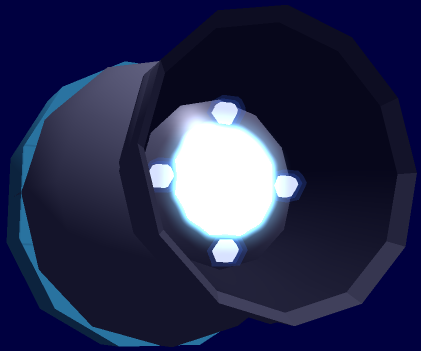Sidebar
Aether-assisted Laser Engine
 Pictued: Aether-assisted Laser Engine out of the prototype PT-X1-1A Tsubame
Pictued: Aether-assisted Laser Engine out of the prototype PT-X1-1A Tsubame
Designed in YE 32 by Kage Yaichiro as part of Project THOUGHT, the Aether-assisted Laser Engine was developed while searching for a cheap STL system which would not violate the law for a civilian craft to utilize, unlike the Turbo Aether Plasma Drive Drive. Developed independently from NAM's na-c3-p3101, the Project THOUGHT variant is adjustable in wavelength rather than set to 510nm, and has between four and eight adjustable focusing emitters inside the nozzle alongside the main emitter. While it can be used in atmosphere, it is best used in space where it is not as harmful and makes the ship harder to detect.
History
During the development of the Tsubame Prototype Fighter, Kage Yaichiro needed to find a cheap form of STL propulsion which the civilian development team could use without breaking the law. Taking on the challenge to try and make the Engine less harmful than the Turbo Aether Plasma Drive Drive he was omitting, the Aether-assisted Laser Engine was the result.
Basic Description
Based on an extremely old (and traditionally agonizingly slow) form of propulsion, the key improvement of this design is the fact the laser is attached to an Aether Generator. With energy to the laser only limited by hardware, the powerful laser can be used to pump out very tightly packed photons which propel the craft in the opposite direction. Between four and eight secondary emitters defocus the laser, in an effort to make it less likely to burn holes through nearby ships and planets…unless such an action is desired. Due to the fact the laser is focused in one direction and only travels at light speed, a craft using this propulsion system is difficult to detect.
The laser is adjustable in wavelength and output, and can thus be used in atmosphere if needed, but it is not recommended. The maximum attainable speed without burning atmosphere is an estimated 3,581 kph/2,225 mph (roughly Mach 3 at sea level), and a speed limit of 400 kph/249 mph is recommended on populated planets so as not to harm and blind inhabitants. Lower wavelengths of light containing less energy are typically used within atmosphere as well.
The speed range of the device is actually anything below 1c, but the acceleration notably drops off well before that even in an ideal system. Due to that, the effective top speed depends on the craft it is used on and typically falls within the normal STL speed standards.
Page Tools
Terms of Service - Privacy Policy
